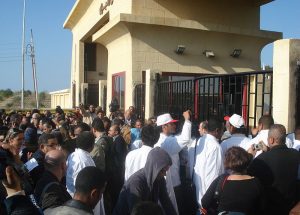
Rafah border crossing between Israel and Gaza, photo via Wikimedia Commons
EXECUTIVE SUMMARY: The situation in the Gaza Strip since the 2005 disengagement debunks three fundamental assumptions that have become axiomatic in the Israeli security discourse:
- that total separation between Israelis and Palestinians will inevitably enhance security and stability;
- that the IDF will comfortably win any future confrontation in the evacuated territories; and
- that Israeli military activity in the previously held territories will enjoy massive international legitimacy and support.
Ever since Israel’s hasty withdrawal from Lebanon in May 2000, it has been axiomatic among Israeli decision-makers that spatial separation between Israelis and Palestinians is a vital Israeli interest, even if not accompanied by a peace agreement. In line with this thinking, Israelis have been repeatedly promised that the implementation of spatial separation, including the removal of Jews from these territories and the construction of a security fence, would reduce daily friction and create a safer and more stable security situation.
Thirteen years after the unilateral disengagement from the Gaza Strip, there is empirical evidence with which to identify the location where a more workable security situation has developed. Is it in the territory where complete separation has been effected, or in the West Bank, where Prime Minister Yitzhak Rabin’s vision of partial separation prevails?
Since Operation Defensive Shield in 2002, the Israeli security forces have been conducting regular counterterrorism activities throughout the West Bank as a matter of course. Generally authorized by the Central Command and the Shin Bet without the need for the approval of the political echelons, this routine activity has given the security forces freedom of action and operational flexibility, which, together with other factors, has ensured relative calm and stability in the West Bank.
Imagine, for example, the launch of kite/balloon firebombs from Jerusalem’s Tzur Baher suburb into the city’s Jewish neighborhoods. The IDF or the Israel Police would send a couple of Jeeps to the neighborhood and neutralize the incident. In stark contrast, the total spatial separation between Gaza and Israel as of the summer 2005 disengagement has denied the IDF freedom of action beyond the border fence. Not that the IDF’s overall capabilities have been reduced, but by transforming the Strip into an ineradicable terror entity that can exact a heavy price from invading Israeli forces, Hamas has succeeded in placing a strategic “price tag” on a wide range of activities short of overall confrontation.
For example, the effectiveness of Israel’s Iron Dome system notwithstanding, Hamas’s rocket/missile arsenal constrains Israel’s daily operational routine as IDF commanders must consider its possible employment in various confrontational scenarios. It is no secret that the balance of costs, risks, and opportunities that accompanies the decision to act in Gaza has become infinitely more complex since the disengagement.
Nor should it be forgotten that a border fence can also benefit Hamas. The fence does indeed help Israel in its effort to prevent hostile infiltration of its territory; but it also enables Hamas to grow stronger and to organize safely under its protective wing. Indeed, under the auspices of the spatial separation, Hamas has managed to build a regular military force comprising battalions and brigades, armed with a large below-ground rocket/missile arsenal and supported by an effective command and control system. None of this would be possible without the full realization of the Israeli leftwing concept of “they are there and we are here.” This is the source of the glaring difference between Hamas’s formidable military position in Gaza and its difficulties in building its strength in the West Bank.
The situation that has developed in the Gaza Strip since the 2005 disengagement thus debunks three fundamental assumptions that have become axiomatic in Israeli security discourse over the past two decades:
- that total separation between Israelis and Palestinians will inevitably enhance security and stability;
- that the IDF will comfortably win any future confrontation in the evacuated territories; and
- that Israeli military activity in the previously held territories will enjoy massive international legitimacy and support.
These are but some of the major considerations that should be seriously weighed by Israeli policymakers before they commit themselves to even more disastrous “spatial separations” in the West Bank and Jerusalem.

No comments:
Post a Comment